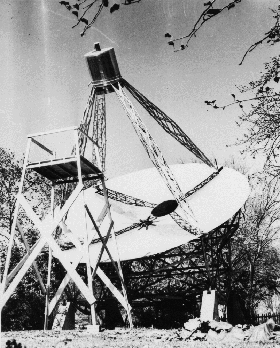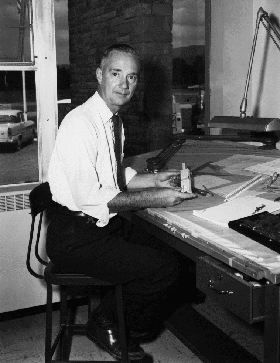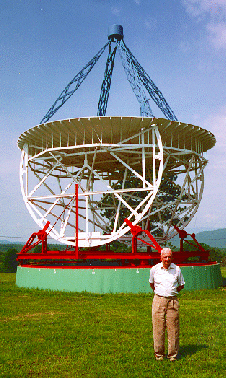Grote Reber's Home-built Radiotelescope
A 9-meter Steerable Parabolic Antenna


|
To construct his parabolic antenna, Reber assembled a framework of 72 radial wooden ribs. Over this, he laid a skin made from 45 sheets of 26-gauge galvanized iron, carefully fitting each to the proper curvature. The antenna was mounted on two movable arches supported by railroad-car wheels. This gave Reber control over elevation; he could shift the pointing direction of his antenna from horizon to zenith at will. This whole assembly was transit-mounted, meaning it relied on the rotation of the Earth to sweep its focus in the (roughly speaking) horizontal plane. This arrangement gave him the ability to cover the entire sky. It was less costly and complex than a full azimuth-elevation mount would have been. The price he paid for this advantage was patience. The completed telescope1 had a diameter of 31 feet 5 inches and a focal length of 20 feet. It weighed about 2 tons and cost $4,000. Reber (with part-time help from two other men on foundation work and heavy lifting) took about 4 months to build it. After completing it in September 1937, he used it until 1948. He then sold it to the National Bureau of Standards, which moved it to Sterling, Virginia. The NBS (now NIST) mounted Reber's telescope on a turntable, thus converting it to an Az-El design, and continued to use it for radio astronomy. In 1952 they again disassembled and moved it, to Boulder, Colorado. There it performed additional observations until 1957, when it was acquired by the National Radio Astronomy Observatory and shipped to Green Bank, West Virginia. Grote Reber himself supervised this renovation and final reassembly, which involved replacement of some wooden members. Today, still capable of useful observation, it stands at the left of the NRAO entrance road near other historic radio astronomy instruments. In 1972 the telescope was listed on the National Register of Historic Places by the Antiquities Commission of the State of West Virginia. |

Above: Reber with telescope at Green Bank (1977?)
Upper left: Original telescope, Wheaton, Illinois, 1938 |

